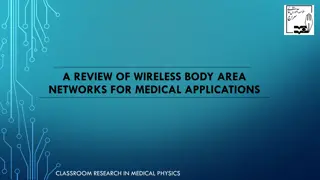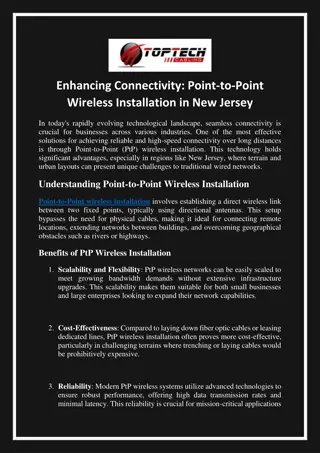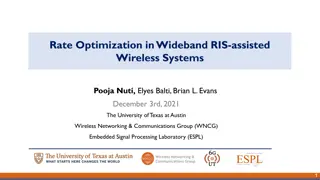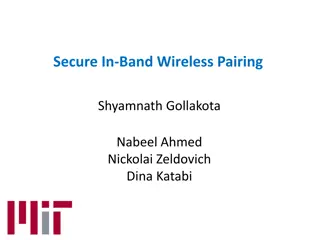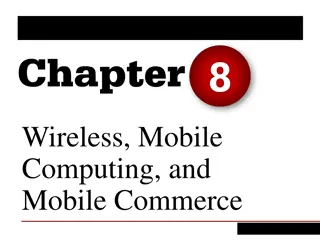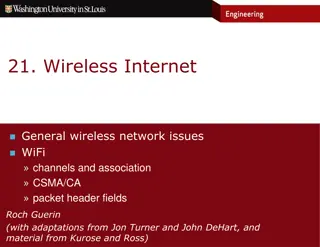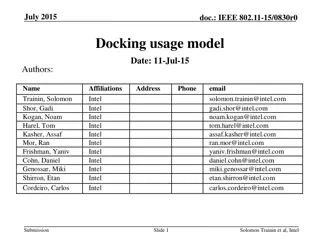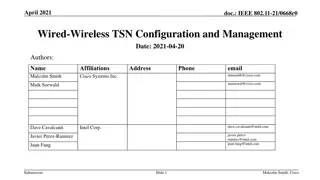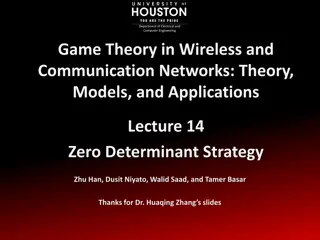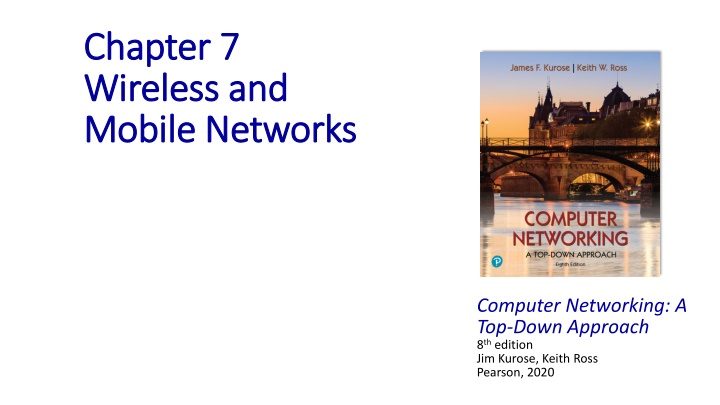
Exploring Wireless and Mobile Networks in Computer Networking
Discover the world of wireless and mobile networks with insights on technologies like WiFi, cellular networks, and network elements. Learn about the challenges of mobility and communication in wireless environments. Stay updated on the latest trends in 4G/5G cellular networks and the integration of Internet protocols.
Uploaded on | 2 Views
Download Presentation

Please find below an Image/Link to download the presentation.
The content on the website is provided AS IS for your information and personal use only. It may not be sold, licensed, or shared on other websites without obtaining consent from the author. If you encounter any issues during the download, it is possible that the publisher has removed the file from their server.
You are allowed to download the files provided on this website for personal or commercial use, subject to the condition that they are used lawfully. All files are the property of their respective owners.
The content on the website is provided AS IS for your information and personal use only. It may not be sold, licensed, or shared on other websites without obtaining consent from the author.
E N D
Presentation Transcript
Chapter 7 Chapter 7 Wireless and Wireless and Mobile Networks Mobile Networks Computer Networking: A Top-Down Approach 8th edition Jim Kurose, Keith Ross Pearson, 2020
Course Roadmap Course Roadmap Ch. 1 Introduction to computer networks and Internet Ch. 2 Application layer Transport layer Ch. 3 Ch. 4 Network layer: data plane Ch. 5 Network layer: control plane Ch. 6 Link layer and LANs Wireless and mobile networks Ch. 7 Ch. 8 Computer network security 2
Wireless and Mobile Networks: context Wireless and Mobile Networks: context more wireless (mobile) phone subscribers than fixed (wired) phone subscribers (10-to-1 in 2019)! more mobile-broadband-connected devices than fixed-broadband- connected devices devices (5-1 in 2019)! 4G/5G cellular networks now embracing Internet protocol stack, including SDN two important (but different) challenges wireless: communication over wireless link mobility: handling the mobile user who changes point of attachment to network Wireless and Mobile Networks: 7-3
Chapter 7 outline Chapter 7 outline Introduction Wireless Wireless Links and network characteristics WiFi: 802.11 wireless LANs Cellular networks: 4G and 5G Wireless and Mobile Networks: 7- 4
Elements of a wireless network Elements of a wireless network wired network infrastructure Wireless and Mobile Networks: 7- 5
Elements of a wireless network Elements of a wireless network wireless hosts laptop, smartphone, IoT run applications may be stationary (non-mobile) or mobile wireless does not always mean mobility! wired network infrastructure Wireless and Mobile Networks: 7- 6
Elements of a wireless network Elements of a wireless network base station typically connected to wired network relay - responsible for sending packets between wired network and wireless host(s) in its area e.g., cell towers, 802.11 access points wired network infrastructure Wireless and Mobile Networks: 7- 7
Elements of a wireless network Elements of a wireless network wireless link typically used to connect mobile(s) to base station, also used as backbone link multiple access protocol coordinates link access various transmission rates and distances, frequency bands wired network infrastructure Wireless and Mobile Networks: 7- 8
Characteristics of selected wireless links Characteristics of selected wireless links 14 Gbps 10 Gbps 802.11ax 5G 3.5 Gbps 802.11ac 802.11 af,ah 600 Mbps 802.11n 4G LTE 54 Mbps 11 Mbps 802.11g 802.11b Bluetooth 2 Mbps Long range outdoor 4Km-15Km Midrange outdoor 200m-4Km Outdoor Indoor 50-200m 10-30m Wireless and Mobile Networks: 7- 9
Elements of a wireless network Elements of a wireless network infrastructure mode base station connects mobiles into wired network handoff: mobile changes base station providing connection into wired network wired network infrastructure Wireless and Mobile Networks: 7- 10
Elements of a wireless network Elements of a wireless network ad hoc mode no base stations nodes can only transmit to other nodes within link coverage nodes organize themselves into a network: route among themselves Wireless and Mobile Networks: 7- 11
Wireless network taxonomy Wireless network taxonomy single hop multiple hops host connects to base station (WiFi, cellular) which connects to larger Internet host may have to relay through several wireless nodes to connect to larger Internet: mesh net infrastructure (e.g., APs) no base station, no connection to larger Internet (Bluetooth, ad hoc nets) no base station, no connection to larger Internet. May have to relay to reach other a given wireless node MANET, VANET no infrastructure Wireless and Mobile Networks: 7- 12
Chapter 7 outline Chapter 7 outline Introduction Wireless Wireless links and network characteristics WiFi: 802.11 wireless LANs Cellular networks: 4G and 5G Mobility Mobility management: principles Mobility management: practice 4G/5G networks Mobile IP Mobility: impact on higher-layer protocols Link Layer: 6-13
Wireless link characteristics Wireless link characteristics (1) (1) important differences from wired link . decreased signal strength: radio signal attenuates as it propagates through matter (path loss) interference from other sources: wireless network frequencies (e.g., 2.4 GHz) shared by many devices (e.g., WiFi, cellular, motors): interference multipath propagation: radio signal reflects off objects ground, arriving at destination at slightly different times . make communication across (even a point to point) wireless link much more difficult Wireless and Mobile Networks: 7- 14
Wireless link characteristics Wireless link characteristics (2) (2) SNR: signal-to-noise ratio larger SNR easier to extract signal from noise (a good thing ) SNR versus BER tradeoffs given physical layer: increase power -> increase SNR->decrease BER given SNR: choose physical layer that meets BER requirement, giving highest throughput SNR may change with mobility: dynamically adapt physical layer (modulation technique, rate) 10-1 10-2 10-3 BER 10-4 10-5 10-6 10-7 10 20 30 40 SNR(dB) QAM256 (8 Mbps) QAM16 (4 Mbps) BPSK (1 Mbps) Wireless and Mobile Networks: 7- 15
Wireless link characteristics Wireless link characteristics (3) (3) Multiple wireless senders, receivers create additional problems (beyond multiple access): B A C C C s signal strength A s signal strength B A space Hidden terminal problem B, A hear each other B, C hear each other A, C can not hear each other means A, C unaware of their interference at B Signal attenuation: B, A hear each other B, C hear each other A, C can not hear each other interfering at B Wireless and Mobile Networks: 7- 16
Chapter 7 outline Chapter 7 outline Introduction Wireless Wireless links and network characteristics WiFi: 802.11 wireless LANs Cellular networks: 4G and 5G Mobility Mobility management: principles Mobility management: practice 4G/5G networks Mobile IP Mobility: impact on higher-layer protocols Link Layer: 6-17
IEEE 802.11 Wireless LAN IEEE 802.11 Wireless LAN IEEE 802.11 standard 802.11b 802.11g 802.11n (WiFi 4) Year Max data rate Range Frequency 1999 2003 2009 11 Mbps 54 Mbps 600 30 m 30m 70m 2.4 Ghz 2.4 Ghz 2.4, 5 Ghz 802.11ac (WiFi 5) 2013 3.47Gpbs 70m 5 Ghz 802.11ax (WiFi 6) 2020 14 Gbps 70m 2.4, 5 Ghz unused TV bands (54-790 MHz) 900 Mhz 802.11af 2014 35 560 Mbps 1 Km 802.11ah 2017 347Mbps 1 Km all use CSMA/CA for multiple access, and have base-station and ad-hoc network versions Wireless and Mobile Networks: 7- 18
802.11 LAN architecture 802.11 LAN architecture Internet wireless host communicates with base station base station = access point (AP) Basic Service Set (BSS) (aka cell ) in infrastructure mode contains: wireless hosts access point (AP): base station ad hoc mode: hosts only switch or router BSS 1 BSS 2 Wireless and Mobile Networks: 7- 19
802.11: Channels, association spectrum divided into channels at different frequencies AP admin chooses frequency for AP interference possible: channel can be same as that chosen by neighboring AP! arriving host: must associate with an AP scans channels, listening for beacon frames containing AP s name (SSID) and MAC address selects AP to associate with then may perform authentication [Chapter 8] then typically run DHCP to get IP address in AP s subnet BSS Wireless and Mobile Networks: 7- 20
802.11: passive/active scanning BBS 1 BBS 1 BBS 2 BBS 2 1 AP 2 1 1 2 AP 2 2 AP 1 AP 1 2 3 3 4 H1 H1 active scanning: (1) Probe Request frame broadcast from H1 (2) Probe Response frames sent from APs (3) Association Request frame sent: H1 to selected AP (4) Association Response frame sent from selected AP to H1 passive scanning: (1) beacon frames sent from APs (2) association Request frame sent: H1 to selected AP (3) association Response frame sent from selected AP to H1 Wireless and Mobile Networks: 7- 21
IEEE 802.11: multiple access avoid collisions: 2+ nodes transmitting at same time 802.11: CSMA - sense before transmitting don t collide with detected ongoing transmission by another node 802.11: no collision detection! difficult to sense collisions: high transmitting signal, weak received signal due to fading can t sense all collisions in any case: hidden terminal, fading goal: avoid collisions: CSMA/CollisionAvoidance B A C C C s signal strength A s signal strength B A space Wireless and Mobile Networks: 7- 22
IEEE 802.11 MAC Protocol: CSMA/CA 802.11 sender sender receiver 1 if sense channel idle for DIFS then transmit entire frame (no CD) 2 if sense channel busy then start random backoff time timer counts down while channel idle transmit when timer expires if no ACK, increase random backoff interval, repeat 2 DIFS data SIFS 802.11 receiver if frame received OK return ACK after SIFS (ACK needed due to hidden terminal problem) ACK Wireless and Mobile Networks: 7- 23
Avoiding collisions (more) idea: sender reserves channel use for data frames using small reservation packets sender first transmits smallrequest-to-send (RTS) packet to BS using CSMA RTSs may still collide with each other (but they re short) BS broadcastsclear-to-sendCTS in response to RTS CTS heard by all nodes sender transmits data frame other stations defer transmissions Wireless and Mobile Networks: 7- 24
Collision Avoidance: RTS-CTS exchange B A AP reservation collision time DATA (A) defer Wireless and Mobile Networks: 7- 25
802.11 frame: addressing 4 2 2 6 6 6 2 0 - 2312 6 seq frame controldurationaddress address 2 address 3 address 4 payload CRC control 1 Address 1: MAC address of wireless host or AP to receive this frame Address 4: used only in ad hoc mode Address 3: MAC address of router interface to which AP is attached Address 2: MAC address of wireless host or AP transmitting this frame Wireless and Mobile Networks: 7- 26
802.11 frame: addressing Internet H1 R1 802.3 Ethernet frame H2 MAC addr R1 MAC addr MAC dest addr MAC source addr H1 MAC addr R1 MAC addr AP MAC addr address 2 address 3 address 1 802.11 WiFi frame Wireless and Mobile Networks: 7- 27
802.11 frame: addressing duration of reserved transmission time (RTS/CTS) frame sequence # (for reliable data transfer) 4 2 2 6 6 6 2 0 - 2312 6 seq frame controldurationaddress address 2 address 3 address 4 payload CRC control 1 1 1 1 2 4 1 1 1 1 1 2 protocol version to AP from AP more frag power mgt more data type subtype retry WEP rsvd frame type (RTS, CTS, ACK, data) Wireless and Mobile Networks: 7- 28
802.11: mobility within same subnet H1 remains in same IP subnet: IP address can remain same switch: which AP is associated with H1? self-learning (Ch. 6): switch will see frame from H1 and remember which switch port can be used to reach H1 BBS 2 H1 BBS 1 Wireless and Mobile Networks: 7- 29
802.11: advanced capabilities Rate adaptation base station, mobile dynamically change transmission rate (physical layer modulation technique) as mobile moves, SNR varies 10-1 10-2 10-3 BER 10-4 10-5 10-6 10-7 1. SNR decreases, BER increase as node moves away from base station 10 20 30 40 SNR(dB) 2. When BER becomes too high, switch to lower transmission rate but with lower BER QAM256 (8 Mbps) QAM16 (4 Mbps) BPSK (1 Mbps) operating point Wireless and Mobile Networks: 7- 30

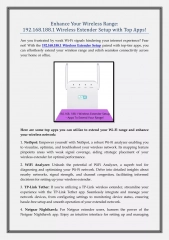
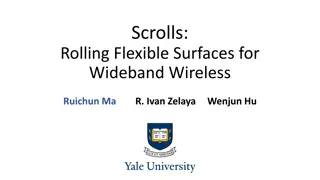
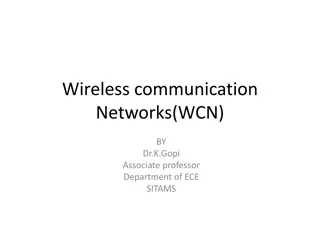

![Long-Range Wireless Charging Market Report & Analysis _ BIS Research [2024-2035]](/thumb/87166/long-range-wireless-charging-market-report-analysis-bis-research-2024-2035.jpg)
